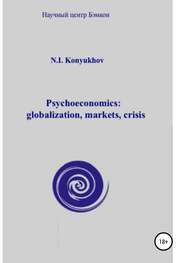
Полная версия:
Psychoeconomics: globalization, markets, crisis
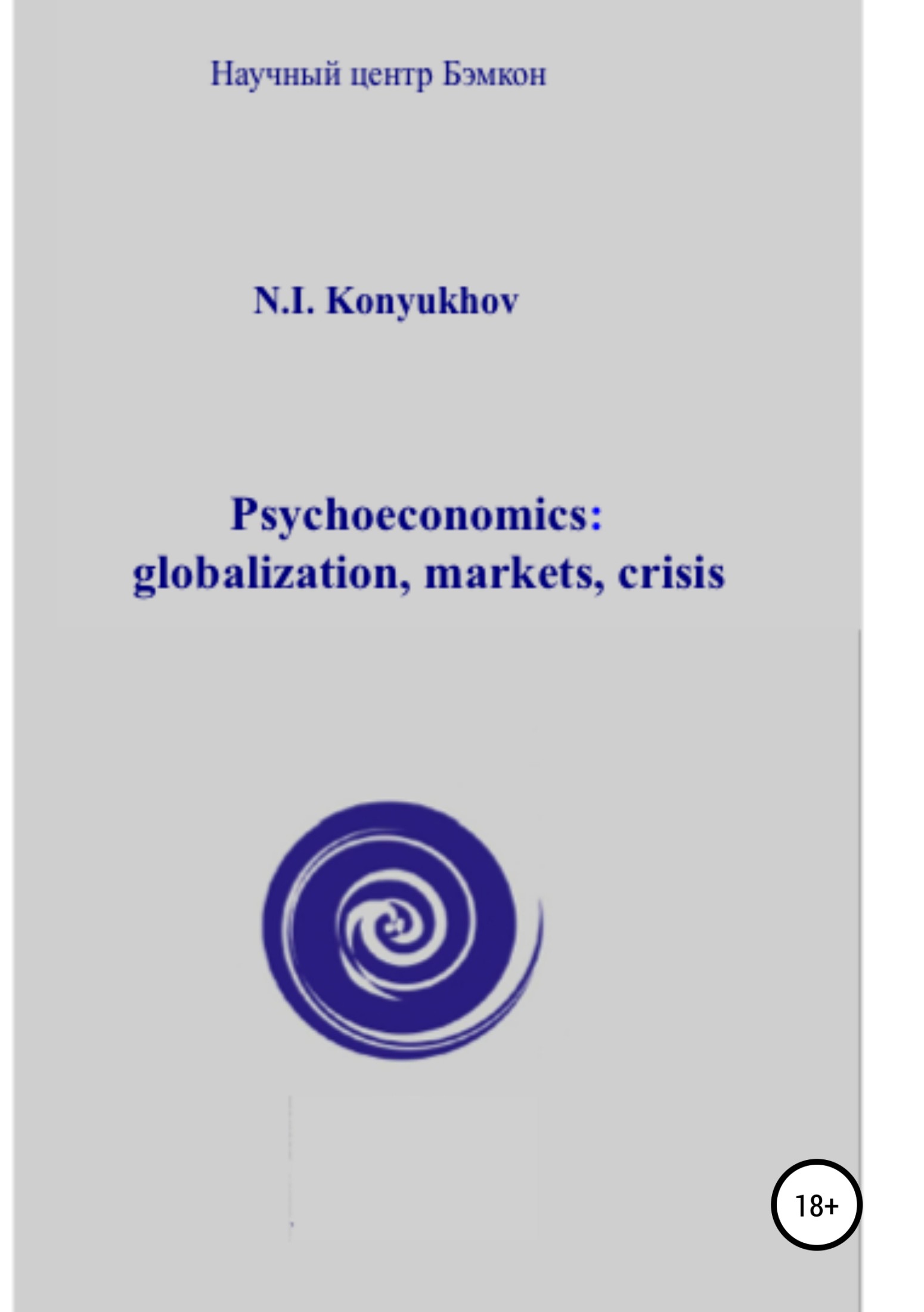
Introduction
For decades, research centers were systematically studying the human changes in the process of practical, as well as industrial, activity, considering the factors of cosmic activity. The results of these studies are presented in books, lectures, articles and presentations made by the leaders and employees of these scientific centers: http://biruch.ru/, http://bemkon.ru/, http://www.sc-bemkon.com/.
The essence of this concept is that the periodicity of socioeconomic development is related to the cyclical nature of the change in the psychotypes of people, and the cyclical nature of solar activity, of the Earth’s rotational velocity. It is about the facts of fundamental dependency between the mankind development and cosmic energies: both electromagnetic and non-electromagnetic ones.
Chapter 1. On psycho-cosmological studies and obtained scientific results
Consider that the length of day (LOD) graph is symmetrically opposite to the graph of the Earth's angular rotational velocity. According to LOD, slowdown of the Earth's rotational velocity is associated with the longer duration of the Earth's day.
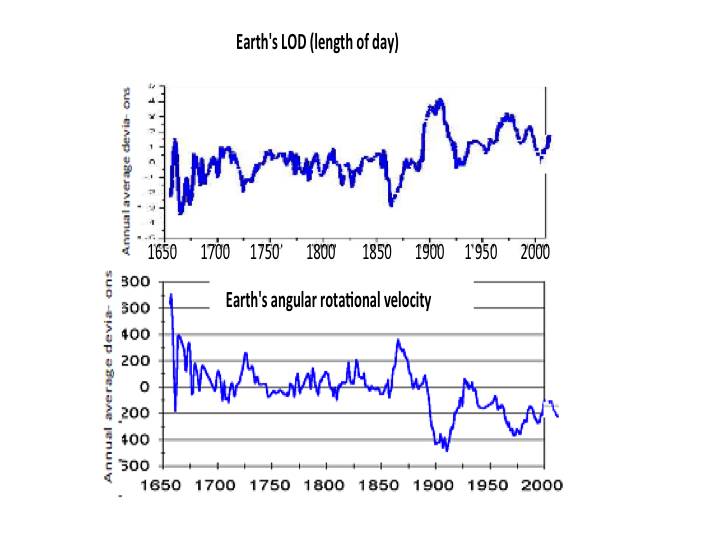
The figure shows the value change over time for the 1650 – 2000 period. (see V.D. Kokurov).

http://dewinforex.com/images/kondr-cycles-4.jpg

www.wikireading.ru/img/388787_13_i_016.jpg
Let us combine them with the well-known graphs of economists.
All fundamental economic and socio-political processes are visually related to these graphs.
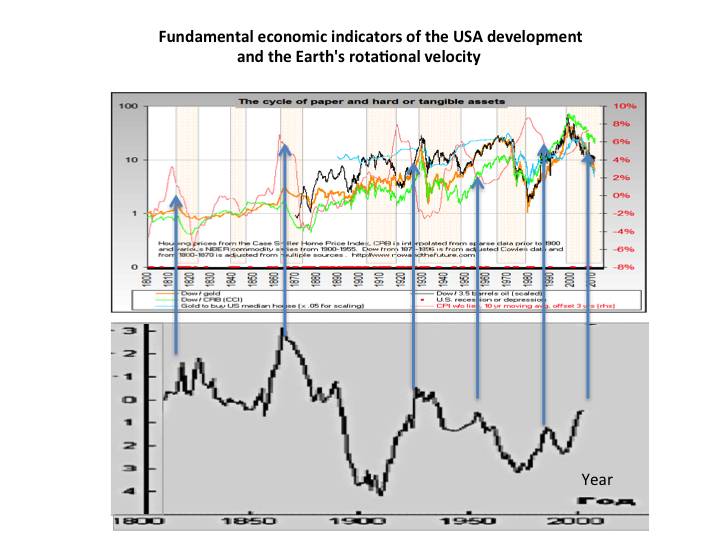
http://nowandfutures.com/key_stats.html
The system of such graphs has been obtained for different countries and for different economic and financial indicators. It leaves no doubt that the Earth's rotational velocity reflects powerful cosmic energies.
It was discovered that different countries respond to cosmic energies differently. In terms of GDP growth rates, all countries are divided into those whose GDP grows with the slowdown of the Earth's rotational velocity, and those whose GDP grows with the growth of the Earth's rotational velocity.
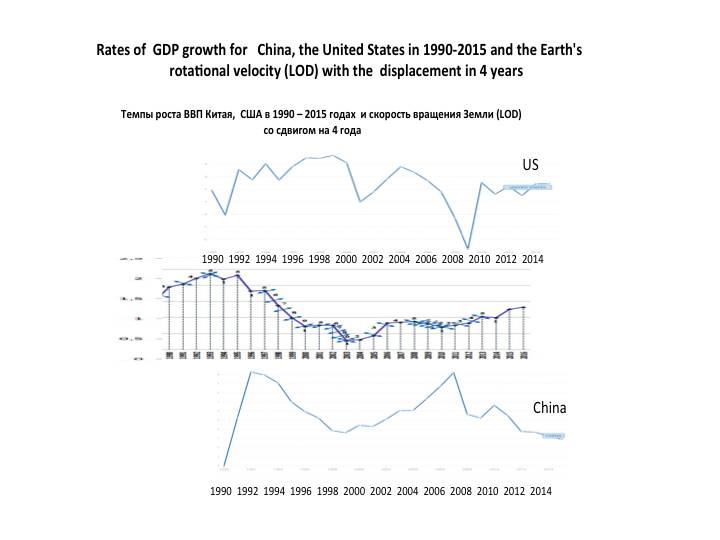
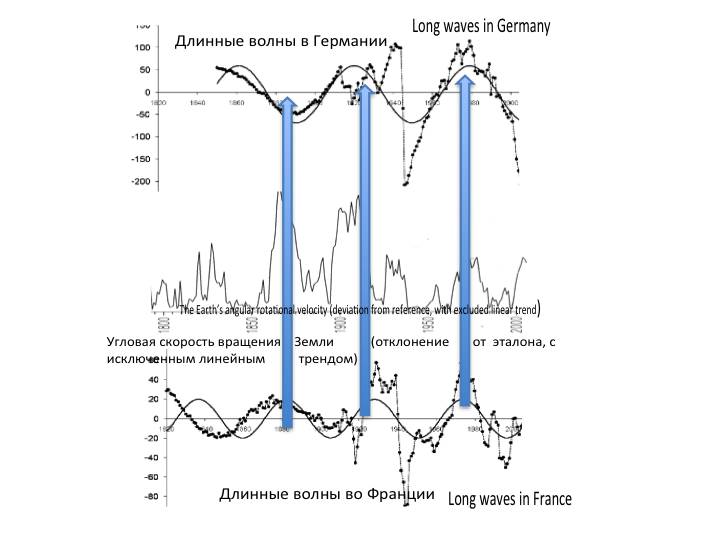
The graphs of long waves, cycles of economic development are taken from the book “Kondratiev waves: aspects and prospects”. Volgograd, 2012. – 384 p.
The growth rates of GDP in the US, China and the Earth's rotation speed
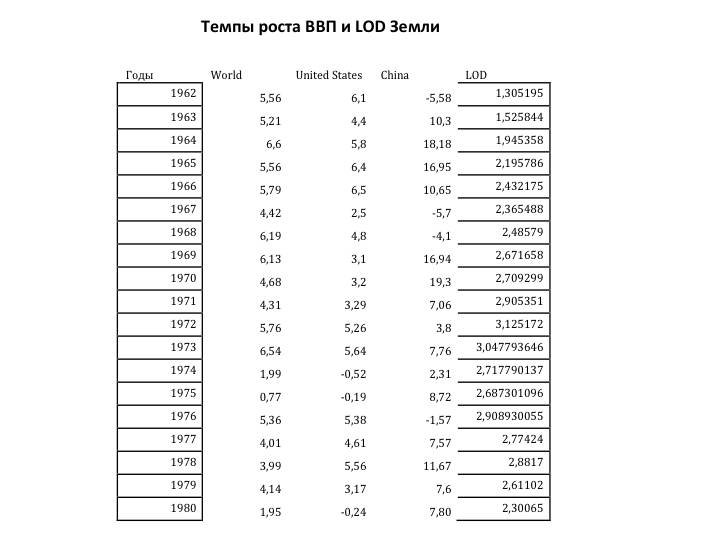
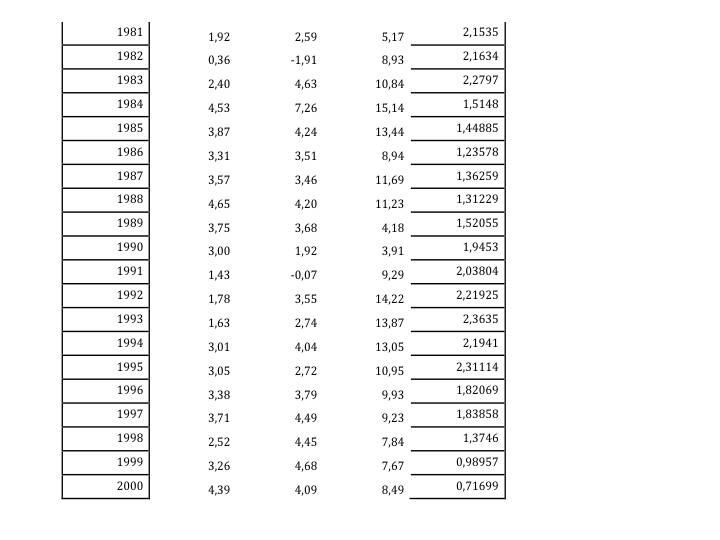

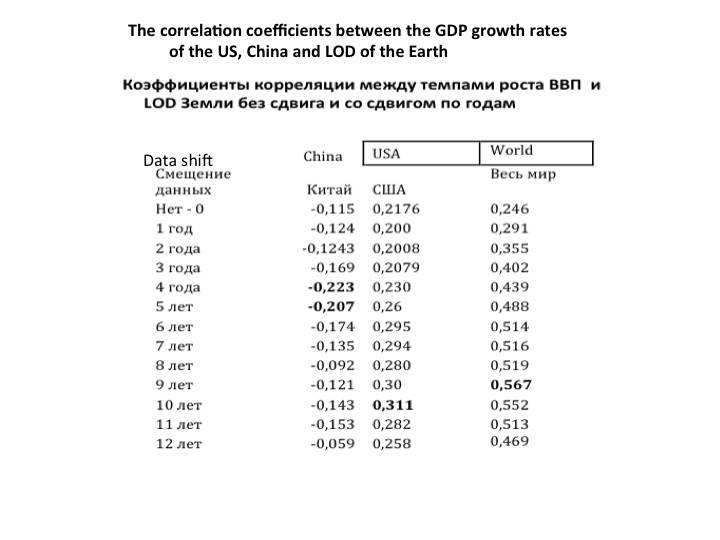
Generalized indicator of economic growth, which is associated with other economic indicators, is the CPI (Consumer Price Index).
Here are the data for the time available for the Earth's rotational speed, for changes in the value of the consumer basket, i.e. the CPI (percentage related to the previous year), and solar activity. These data are from the beginning of the XIX century.
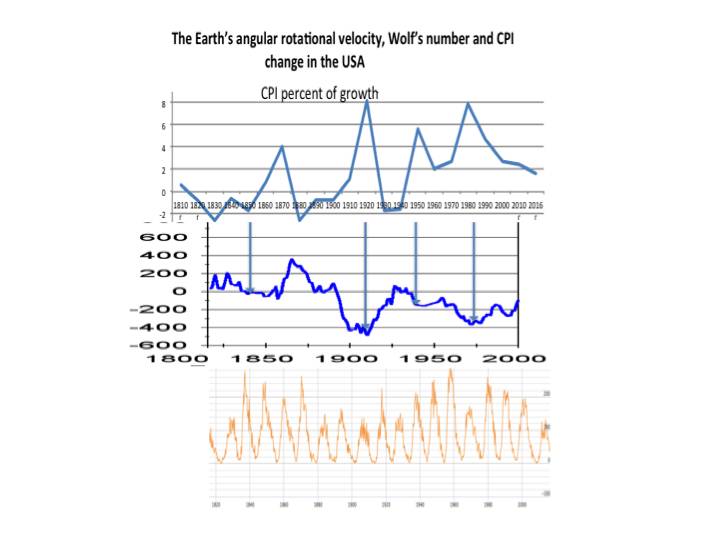
The CPI value is taken as an average of a decade. Graph of the CPI changes (mean per decade) accurately rests on the chart of the Earth's angular velocity. Lack of the cosmic ether – the high is price of the consumer basket. The reason is the low productivity due to low physiological, mental, intellectual capabilities of people. In this case, the measurement step in 10 years smooths the data on changes in the cosmic ether density under the influence of the various planets and by changing the direction of spin of the ether flows. With this step of the measurement charts do not need offset for a few years.
Growth of gravity-spin energy leads to increase of the efficiency of industry. And it is not only in our millennium. This is how society was changing throughout history. Greek cities grew more intense in the decline of temperature, which is an indirect sign of entry of Earth more powerful cosmic ether vortices. (The breath of history, pp. 488-495). We are developing rapidly under the influence of non-electromagnetic cosmic energies. And what about Sun? It is important, that we not die of starvation due to the termination of the growth of vegetation. If there is not enough solar energy – cereals do not grow – here comes death from starvation. But if there is some minimum of solar energy for food security, then the development is more dependent on the density of the cosmic ether. The combination of these two cosmic energies is important and determines the features of the development we have at a given point in history (N. Konuhov, 2016b).
Relationships between of solar activity and cosmic non-electromagnetic energies are of probabilistic character. If we take a typical graphs of ratio of the Wolf’s numbers and the various features of non-electromagnetic cosmic energy, then this relationship is difficult to see.
L. Konstantinovskaya shows resulting chart with a different visualization of the solar radiation data – there is a deviation from the mean for all years. The dependence of the two kinds of cosmic energies become visible. http://www.astronom2000.info/wp-content/uploads/2011/06/7_6.gif
The points of change in a sign of the Earth’s rotational acceleration are at the same time the points of changing in the intensity of solar radiation for decades and centuries.
The points of change in a sign of the Earth’s rotational acceleration are at the same time the points of changing in the intensity of solar radiation for decades and centuries.
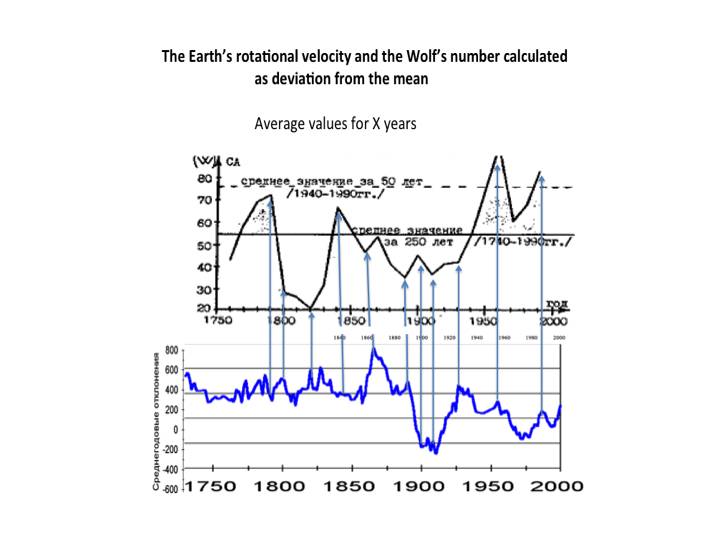
Notice, how the combination of turns in the Earth's rotational speed and intensity of solar radiation is consistent. The low values of solar intensity on turns are consistent with high values in turns of gravity-spin energies, energies of the cosmic ether. It is the ratio of these energies had been substantiated by V. Dyatlov through the law of the full electromagnetic and gravity-spin currents. According to his calculations, the gravity-spin energy growth is combined with falling of electromagnetic energy if we are talking about a separate cosmic system. In his terminology it is vacuum domain. But it is on the scale of centuries.
Similar dependencies exist on other scales.
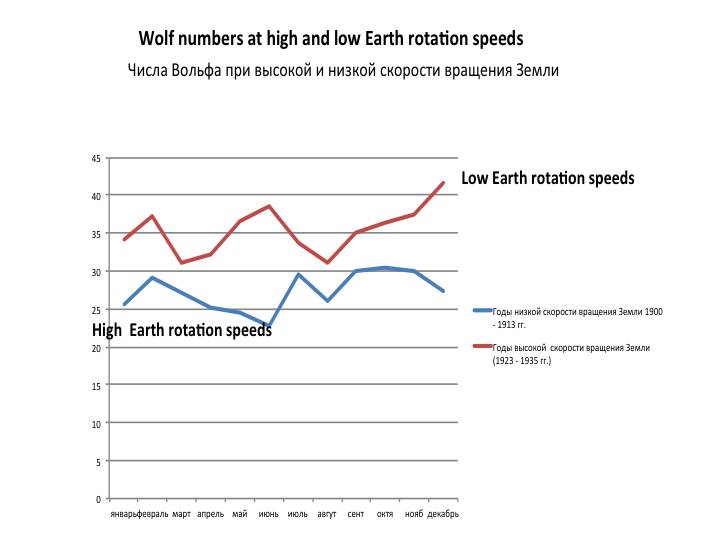
For groups of people examined at different stages of the day and annual cycles the following data were obtained: EEG (electroencephalogram), ECG (electrocardiogram), solved test results, including those that diagnose intellectual qualities, personality traits, unconscious activity (Smirnov's technique etc.). This made it possible to predict changes in people at the change of the Earth's rotational velocity, at a certain arrangement of planets (which is related to the Earth's rotational velocity). This manifests itself in economic growth, in the growth of people's physiological activity and even biota, particularly in growth of tree rings.
Yu. P. Demakov discovered two tree clusters: one of them grows better at the growth of the Earth's rotational velocity, whereas the other – at its slowdown. GDP growth rates of different countries, achievements of athletes are similarly divided into two clusters, two groups.

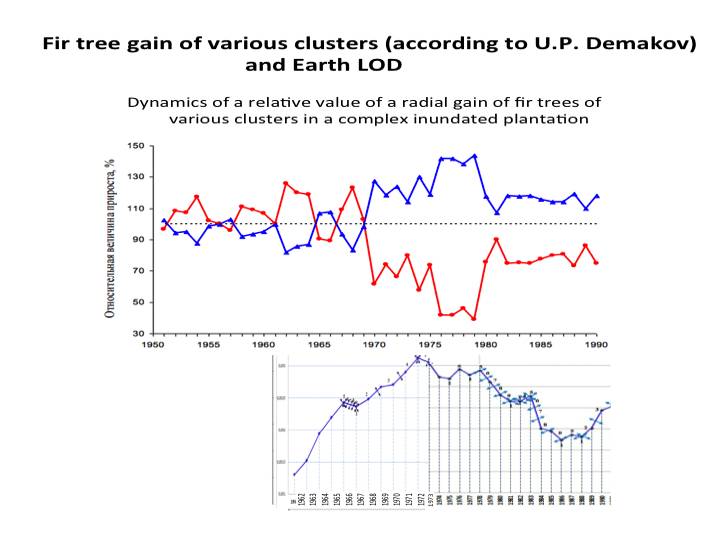
The Earth's rotational velocity is related to many diverse indicators, which are measured by statistics.
Next, we analyze solar activity, but we take into account its relationship with the Earth's rotation speed.
References:
1. Космические энергии и человечество: гаплогруппы, психотипы, социум. – М., 2018. – 379 с
2. Психологические термины и психокосмические концепции в истории, социологии, экономике, маркетинге, медицине. Словарь-справочник. Том I. – М., 2018. – 508 с.
3. Психологические термины и психокосмические концепции в истории, социологии, экономике, маркетинге, медицине. Словарь-справочник. Том II. – М., 2018. – 500 с.
4. Здоровье в резонансе с космическими энергиями: факты, графики, расчеты. – М., 2018. – 291 с.
5. В резонансе с космическими энергиями: психокоррекция и маркетинг . / Н.И. Конюхов, О.Н. Архипова, Е.Н. Конюхова, А.Р. Хайруллин – М., 2018. – 381 с.
6. Космические энергии и человечество: графики для размышлений. Издание 2-е, доп. – М., 2017. – 508 с.
7. Психокосмические энергии и Россия. М.: 2017. – М.: Перо. – 355 с.
8. Психокосмические энергии и экономический рост. – М.: 2017. – 231 с.
9. Психокосмические энергии и терроризм. – М., 2016. – 258 с.
10. Человек в вихрях эфира. – М.: Перо, 2016. – 437 с.
11. Психокосмические энергии: протесты, революции, рывки в развитии. – М.: 2016, с.310-330
12. Интеллект руководителя: практикам и исследователям. – М.: 2015. – 678 с.
13. Дыхание истории. – М., 2015. – 831 с.
14. Экономический кризис: кто виноват и что делать. М.: 2014. – 400 с.
15. Экономический кризис: Космос и люди. М.: 2014. – 230 с.
16. Мягкая сила в истории Германии : уроки 30-х годов XX века. – M.: 2014. – 313 c.
17. Психоэкономика . М.: 2012. – 2-е изд. – 540 c.
18. Психоэкономика: глобализация, рынки, кризис. М.: 2012. – 300 c.
19. Шизоидность: ?! М.: 2011. – 352 с.
20. Словарь-справочник по психологии. – М.: 1996. – 160 с.
21. Акмеология и тестология. М.: 1996. – 380 с. И др.
22. Анализ и прогноз фондовых рынков. https://bemkon.ru/Fragments/Article14.aspx
23. Формула революций, массовых протестов: открытия российских ученых https://bemkon.ru/Fragments/Article17.aspx
24. In resonance with cosmic energies: terrorism and marketing [Текст] / Konyukhov N., Arhipova O., Konyukhova E., Hayrullin A. ; Research and training center Biruch, Research center Bemkon. – Moscow: [s. n.], 2018. – 284 p.
25. Cosmic energies and mankind: graphs for reflection [Текст] / N. I. Konyukhov ; Research and training center Biruch, Research center Bemkon. Moscow: Гарант, 2018 – 349 p.
26. Psycho-cosmic energies and Russia [Текст] / Konyukhov N. I. ; Research and training center Biruch, Research center Bemkon. Moscow: Pero, 2017. – 219 p.
27. Psycho-cosmic energies and economic growth [Текст] / Konyukhov N., Arhipova O., Konyukhova E. ; Scientific and research centre "Bemkon. Moscow: Перо, 2017. – 235 p.
28. Economic crisis. Chapters from the book. / N.I. Konyukhov . – М.; Publishing Office Pero, 2015. – 240 p.
29. Economic crisis: Cosmos and people / N.I. Konyukhov . – М.; Publishing Office Pero, 2014. – 221 p.
30. Psychoeconomics: Clobalization, Markets, Krisis. N.I. Konyukhov – М.; Publishing Office Pero, 2014. – 309 p.
31. Cosmic energies and mankind: graphs for reflection. [Text] / N.I. Konyukhov. – – M., 2018. – 371 с.
Chapter 2. Psychotypological changes in the elite, the economically active population as an influential factor in socioeconomic processes in the world
Society develops erratically. At more critical and stressful points of development, people’s psyches stretch and are overstretched. And it happens that those in the middle of such stress exert the greatest effect on the environment at critical times of social development. This usually means people with accentuation characteristics. Most of the Russian tsars, according to the psychiatrist A. Kovalevsky, were people with traits that deviated from the norm. Most of successful prominent managers in Russia, according to the research of S. Epifantsev, have traits of accentuation. Cesare Lombroso’s opinion about talented people likewise concerns the fact that they are, to a great degree, accentuated, and frequently with psychological deviations. People have various personality traits, in some languages the number of them is in the tens of thousands. But what is amazing, regardless of the historical period in a state of stress or overstress, is that people arrive at the same deviations from the norm. These deviations and the typology of people with psychological deviations are studied by psychiatrists. In our research, the analysis does not concern psychotypes with psychological deviations, but rather the variable personality traits and their typology. But these variable personality traits are often grouped in clusters that are close to psychological deviations. These are often accentuated people.
2.1. Basic psychological terms
Terms and their meanings are the language of science. Without a precise language it is impossible to communicate ideas precisely and clearly.
Considering the inclusion of English-speaking scholars in the discussion, an English translation of the definitions of terms is presented.
Hysteroid accentuation – a type of accentuation where the personality at the level of dynamic stereotypes is increasingly emotional, impressionable, “high strung”, and loves the attention of people and cannot be without it. In the process of practical work, he may attract attention to himself by committing acts that others will not commit (such as to pitch some idea, then unexpectedly swear at someone, then compliment them, then not agree to something, then complain to an older supervisor in front of everyone, etc.). And these actions are dictated less by the substance of the problem than by an unconscious wish to attract attention. The hysteroid type of accentuations or the demonstrative type strive for attention and acknowledgement by those around him by any means available.
Paranoiac accentuation – the psychotype of a person for whom it is characteristic to strive toward a goal, at times to the detriment of those around him. The main characteristics of such people are their difficulties in controlling the strong emotional reactions that occur, and stability, perseverance, single-mindedness, and the presence of persistent orientation to attaining goals (at times without any good reason), right up to formation of predominant ideas or relationships. Most successful business leaders are accentuated paranoiacally. Their predominant idea is to start the ball rolling, get to work. The paranoiac or “trapped” type of accentuations are stuck on something under the influence of a “predominant idea”.
Resonant psychotype – one of the basic psychotypes of the gainfully employed population, which ensures the success of the society and of the people in a given historical epoch, in given types of activity or in a given specific circumstance… Usually these are domain experts, frequently with traces of paranoia.
Postresonant psychotype – a type of person who imitates the resonant psychotypes and learns from them. Usually these are social motivators, often with traces of obsessiveness.
Post-postresonant psychotype – a psychotype which psychologically and logically comes to replace the postresonant psychotype. Most often these are social motivators, often with traces of hysteria.
“Domain expert” metaprogram – a psychotype and simultaneously a strategy for satisfying a human need, conditioned by the presence of corresponding systems of dynamic stereotypes, through analyzing and managing technological processes, owing to personal work in an activity whose purpose is domain specific (image, object, process etc.).
“Social motivator” metaprogram – a psychotype and at the same time a strategy for satisfying human needs, conditioned by the presence of corresponding systems of dynamic stereotypes, through analyzing and managing other people, and through personal work or activity in a system of interpersonal relations, whose aim is related to forming needed motivation or behavior of other people.
People change under the influence of social and natural factors, including solar activity. At certain peaks of solar activity, people can become highly agitated and particularly emotional. They become increasingly hysteroid and psychopathic.
All of the Russian revolutions (1905, 1917, 1991) coincided with solar peaks that were the largest in a decade.
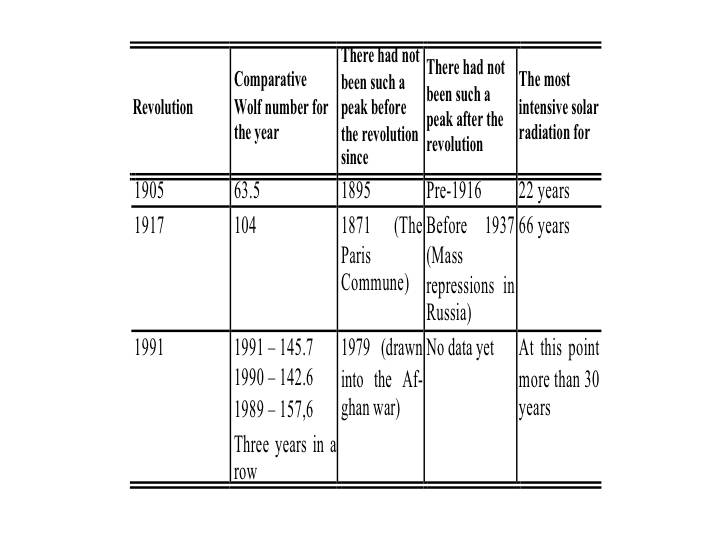
In years of solar tranquility, the average annual number of such sunspots is small – 10 – 20.
Peaks of solar activity are also peaks of social protest and revolution. Social roles that had previously been accepted (stable social dynamic stereotypes) – were swept away. Society was ready to accept new roles, to begin to live according to new customs, traditions, and laws. In the language of the physiology of higher nervous function, the apparatus for closing and opening nerve impulse circuits has succumbed to change to a much greater degree than usual.
People are capable of behaving and changing their dynamic stereotypes to a much greater degree than usual. The influence of hysteroids and psychopathic personalities automatically becomes stronger and more relevant. They have higher sociometric ratings and exert a more effective influence on those around them than usual. Revolution, for the hysteroids that take part in it, frequently becomes the moment of their fullest emotional satisfaction – on the barricades, at the center of attention, all in one emotional outburst… Even actors don’t get such an emotional outburst on the stage.
One might counter that not all peaks of solar activity end up in revolutions. True enough. Several peaks of solar activity have not ended up in revolution in Russia.
There are two exceptions: 1991 (the incursion of troops into Afghanistan) and 1957–1958. The entry into Afghanistan turned the agitation of people and their heightened psychopathy into an emotion about “fulfilling international obligation”. Nevertheless the decision itself was in large measure impulsive.
But the period from 1957 to 1958 deserves a separate analysis. The atypical behavior of the Soviet people must be explained by the fact that after the war everyone got used to being compliant, and firm dynamic stereotypes were engineered to obey orders and meet the demands of the powerful agencies, while at the same time (!) the functioning of the apparatus opening and closing conditioned reflexes became more active. This suffices to minimize the effect of the Sun for up to 20 years. That is on the one hand.
On the other hand, the influence of the country’s authorities on the people was emotionalized. The people were emotionalized. The accumulated psychopathic energy poured out into emotions because of the denouncing of Stalin’s personality cult, the launch of the first sputnik, the World Youth Festival, the construction of new housing – “khruschevki” and so on and so forth. Steam was let off with the help of these and other events.
Rates of economic development (N. Kondratiev curve) are linked to solar activity.
Of the 12 peaks of solar activity since 1870, in 8 cases economic development slowed after peak solar activity passed, and at each stage of growth of the Kondratiev cycle, a peak of solar activity preceded maximization.
An economically active population first becomes increasingly emotional, then returns to a normal state. In the normal state, the economic laws discovered by science are active. In a psychopathic state of the population and the subjects of economic activity, they are deformed depending on the degree of psychopathization of both the economically active population as well as the elite.
2.2. Causes of the crisis today: analogies in the past
The wavelike change in people’s psychotypes and the economically active population is superimposed on the wavelike change in the quality of the elite. In countries that are developing under the influence of endogenous factors, that is, that depend on the influence of neighboring countries and external factors to a lesser degree than others, the quality of the elite changes radically in the span of three generations. Studies by F. Braudel and other scholars show that it has happened like this for millennia.
The psychotypes of the elite and economically active population are multifaceted. Let’s take just one facet: the relationship between “domain experts” and “social motivators”. People think with metaprograms.
The “social motivator” is oriented toward the opinion of other people, while the “domain expert”, when making a decision, is oriented toward technological processes, which he tries to manage.
The “social motivator” is oriented toward the opinion of other people, while the “domain expert”, when making a decision, is oriented toward technological processes, which he tries to manage.
The role and significance of domain experts and social motivators has fluctuated throughout history.
In this respect there is the study by Y.A. Van Houtte, which finds a pendular movement of industry between cities, towns and villages throughout the Netherlands from the Middle Ages to the eighteenth century. Initially, industry in the Netherlands was scattered through the villages. In the thirteenth and fourteenth centuries, industry began to migrate to the cities. After the long depression of 1350–1450, villages were again deluged with tradesmen. Guilds no longer satisfied them, and labor costs became more expensive in the city. But in the workshops it was primarily the “social motivators” who occupied the leading position in their management – people who were able to unify others and force them to make cooperative sacrifices for common goals.
In the sixteenth century, according to Van Houtte, cities again became attractive for Dutch tradesmen, while in the seventeenth century, the village again attracted the tradesmen. Van Houtte explains this migration in terms of the level of taxation. ¬But taxes are more often imposed by “social motivators” and not by “domain experts”.
This is generally true for any unorganized backgrounds and associations of people. Real democracy is replaced in time by the management by “social motivators”. Eventually this management leads to oppression of “domain experts”, and then, to conflict with them. Without a certain number of “domain experts,” the “social motivators” have nothing to do, no one to exploit, and thus they need to create the conditions that would attract “domain experts” to them again.
On the whole, this oscillating interaction of “social motivators” and “domain experts” has enabled a more tempestuous development of society. This much is clear: this is how compromising conditions of coexistence, an optimal social and economic structure of society, are more quickly worked out between “domain experts” and “social motivators”. In the Netherlands, this oscillating movement of the tradesmen generally enabled growth of labor productivity and the development of industrial relations. This correlates with Holland’s intensive development in those years.
The relationship between “domain experts” and “social motivators”, their oscillating rotation, is likewise the basis of the rotation of the main centers of economic development. Thus, in the Middle Ages there was a competition for primacy in the system of economic relations between Genoa and Venice. Loss of the leadership positions by these city-states was frequently associated with one of the groups of “social motivators” coming into power. As a rule, social motivators come to power under the guise of democracy. This period of exceptional activity of the “social motivators” is a period of intensive development of democracy. But then the “social motivators” have to either lose power under the pressure of the masses, or cede it to the “domain experts”.



